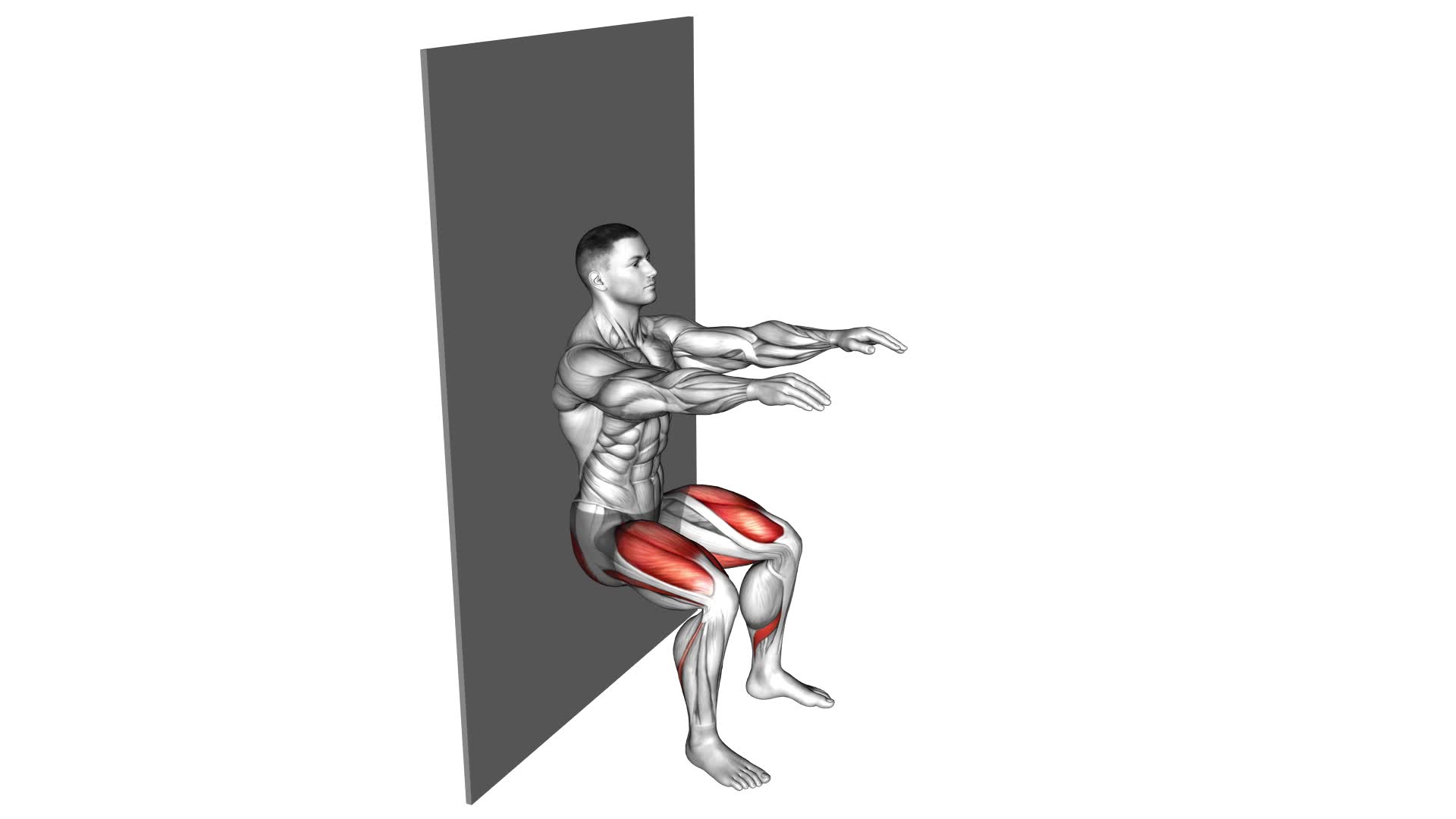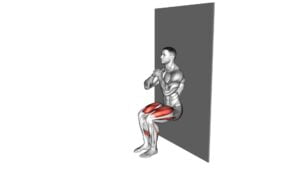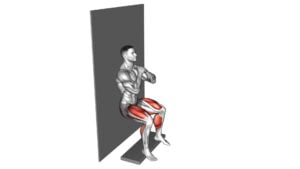Sit (wall) – Video Exercise Guide & Tips

Get ready to tone your muscles and strengthen your core with the Sit (wall) exercise! This video exercise guide will show you the proper form and technique, as well as variations and modifications to challenge yourself. Avoid common mistakes and learn tips for a more effective workout.
Watch This Exercise Video
Whether you're a beginner or a fitness enthusiast, incorporating the Sit (wall) exercise into your routine will help you achieve your fitness goals.
Let's get started!
Key Takeaways
- The sit (wall) exercise helps prevent injuries by strengthening legs, hips, and glutes.
- It engages multiple muscle groups simultaneously for time-efficient workouts.
- The exercise builds strength in quadriceps, hamstrings, and calves.
- It improves core stability and enhances workout effectiveness.
Benefits of the Sit (wall) Exercise
Get ready to discover the benefits of the Sit (wall) exercise and how it can improve your strength and stability.
The Sit (wall) exercise is a simple yet effective movement that targets your lower body muscles while also providing a range of other benefits.
One of the main advantages of this exercise is its ability to prevent injuries. By strengthening your legs, hips, and glutes, you can improve your overall stability and balance, reducing the risk of falls and other accidents.
Additionally, the Sit (wall) exercise is highly effective for your workout routine. It engages multiple muscle groups simultaneously, making it a time-efficient choice for those looking to maximize their training sessions. This exercise can help build strength in your quadriceps, hamstrings, and calves, as well as improve your core stability.
By incorporating the Sit (wall) exercise into your routine, you can enhance your workout effectiveness and achieve your fitness goals faster.
Proper Form and Technique
To perform the Sit (wall) exercise correctly, position yourself with your back against a wall and your feet shoulder-width apart. Maintaining proper form and technique is crucial to maximize the benefits of this exercise and avoid injury. Here are some tips for improving your technique:
- Engage your core: As you lower your body into the sitting position, focus on tightening your abdominal muscles. This will help stabilize your spine and prevent excessive arching or rounding of the back.
- Keep your knees in line with your toes: As you squat down, make sure your knees are tracking in the same direction as your toes. Avoid letting your knees collapse inward, as this can put stress on the knee joints.
- Distribute your weight evenly: Shift your weight onto your heels and keep your feet flat on the ground. This will help you maintain balance and stability throughout the exercise.
- Control your descent: Lower yourself down slowly and with control, aiming to reach a 90-degree angle at the knee joint. Avoid plopping down or bouncing off the wall, as this diminishes the effectiveness of the exercise.
Variations and Modifications
Now let's explore the various ways you can modify and customize the sit (wall) exercise to suit your needs and abilities.
Modifications can offer specific benefits such as targeting different muscle groups or accommodating physical limitations.
Common modification techniques include adjusting the depth of the wall sit or incorporating additional equipment like resistance bands or stability balls.
There are also variations for different levels, allowing beginners to gradually progress and experienced individuals to challenge themselves further.
Benefits of Modifications
Experience the advantages of incorporating modifications into your wall sit routine. By making modifications to your wall sit exercise, you can enhance your workout and target different muscle groups.
Here are four benefits of incorporating modifications:
- Increased intensity: By adding weights or resistance bands to your wall sit, you can intensify the exercise and challenge your muscles even more.
- Targeted muscle engagement: Modifying your wall sit by changing your foot position or adding pulses can help you target specific muscle groups, such as the inner thighs or glutes.
- Improved balance and stability: By performing a single-leg wall sit or incorporating balance exercises, you can improve your balance and stability while strengthening your leg muscles.
- Injury prevention: Modifications allow you to adapt the exercise to your fitness level and avoid putting excessive strain on your joints, reducing the risk of injury.
Incorporating modifications into your wall sit routine can provide a range of benefits, allowing you to customize your workout and achieve your fitness goals more effectively.
Common Modification Techniques
By incorporating common modification techniques, you can further enhance your wall sit routine and target specific muscle groups. Modification techniques allow you to tailor the exercise to your fitness level and goals.
One modification is to vary the duration of the wall sit. Start with shorter intervals and gradually increase the time as you build strength.
Another modification is to change the position of your feet. Placing your feet wider apart targets the inner thighs, while bringing them closer together engages the outer thighs.
You can also add resistance by holding a weight on your lap or using a resistance band around your thighs.
These exercise modifications help to challenge different muscles and prevent plateauing in your wall sit routine.
Variations for Different Levels
To cater to individuals of different fitness levels and goals, there are various modifications and variations you can incorporate into your wall sit routine.
Here are some options for different levels:
- Beginners: If you're new to wall sits or have limited lower body strength, start by performing the exercise with a shallower wall sit angle. This will decrease the amount of weight you have to bear and make it easier to hold the position.
- Intermediate: Once you feel comfortable with the basic wall sit, you can progress by increasing the duration of the hold. Aim to gradually increase your hold time by 10-15 seconds each week.
- Advanced: For those looking for an extra challenge, you can try incorporating additional movements into your wall sit routine. Examples include adding a weight plate on your lap or performing wall sit pulses to further engage your leg muscles.
- Regressions: If you find the wall sit too difficult, you can try modifying the exercise by using a stability ball against the wall. This will provide additional support and help you build strength gradually.
By incorporating these variations and modifications, you can tailor your wall sit routine to your specific fitness level and goals.
Now, let's move on to the next section and discuss some common mistakes to avoid.
Common Mistakes to Avoid
To ensure you're performing the sit (wall) exercise correctly and preventing injuries, it's important to pay attention to proper form and utilize injury prevention techniques.
Demonstrations of proper form can help you understand the correct positioning of your body and the movement involved.
Additionally, incorporating injury prevention techniques such as engaging your core, maintaining proper alignment, and avoiding excessive strain can help you avoid common mistakes and maximize the effectiveness of the exercise.
Proper Form Demonstration
Avoid common mistakes and maintain proper form when performing the sit (wall) exercise. Proper form demonstration is essential for maximizing the benefits of this exercise. Here are four key tips to help you maintain proper form:
- Position yourself against a wall, with your back flat against it and your feet shoulder-width apart.
- Slide down the wall until your knees are at a 90-degree angle, making sure your thighs are parallel to the floor.
- Keep your core engaged by pressing your lower back into the wall.
- Ensure that your knees are directly above your ankles, not extending past them.
By following these guidelines, you won't only target your lower body muscles effectively but also minimize the risk of injury.
Speaking of injury prevention techniques, let's now explore some strategies to keep you safe during the sit (wall) exercise.
Injury Prevention Techniques
Make sure you maintain proper form and avoid common mistakes to prevent injuries while performing the sit (wall) exercise. Injury prevention is crucial when engaging in any exercise routine. To minimize the risk of injury, it's important to follow some key techniques.
Firstly, ensure that your back is flat against the wall and your feet are hip-width apart. This will help maintain proper alignment and prevent strain on your lower back.
Secondly, avoid leaning too far forward or backward, as this can put unnecessary stress on your knees and ankles.
Lastly, if you have any pre-existing conditions or injuries, consult with a healthcare professional before attempting the sit (wall) exercise.
Tips for a More Effective Workout
Get the most out of your workout by incorporating these practical tips:
- Focus on improving muscle activation: Engage the targeted muscles throughout the exercise to maximize your results. For example, when performing a sit (wall) exercise, focus on squeezing your glutes and engaging your core as you lower yourself down the wall. This will help to activate and strengthen the muscles in your lower body more effectively.
- Incorporate resistance training: Adding weights or resistance bands to your workout routine can increase the intensity and challenge your muscles even more. This won't only improve muscle activation but also help to maximize calorie burn. Consider using dumbbells or resistance bands during your sit (wall) exercise to make it more challenging and effective.
- Increase your workout intensity: To get the most out of your workout, try incorporating high-intensity intervals or circuit training. This involves alternating between periods of high-intensity exercise and short rest periods. For example, you can perform sit (wall) exercises for 30 seconds, followed by a 15-second rest, and repeat for several rounds. This will help to elevate your heart rate and maximize calorie burn.
- Stay consistent and vary your workouts: Consistency is key when it comes to seeing results. Aim to exercise regularly and make it a part of your routine. Additionally, vary your workouts to prevent plateaus and keep your body challenged. Try different variations of the sit (wall) exercise or incorporate other exercises that target similar muscle groups to keep your workouts effective and exciting.
Incorporating the Sit (Wall) Exercise Into Your Routine
To effectively incorporate the sit (wall) exercise into your routine, consistently engage your glutes and core while lowering yourself down the wall during each repetition. One great way to incorporate this exercise into a high-intensity interval training (HIIT) routine is to include it as an active recovery exercise between more intense movements. For example, after completing a set of burpees or jump squats, take a break and perform a set of sit (wall) exercises. This will help to keep your heart rate up and maintain the intensity of your workout.
Another effective way to utilize the sit (wall) exercise is as a warm-up for squats. By performing a few sets of sit (wall) exercises prior to your squat routine, you can effectively activate your glutes and core, which are key muscles used during squats. This will help to improve your squat form and stability, allowing you to lift heavier weights and reduce the risk of injury.
Frequently Asked Questions
How Long Should I Hold the Sit (Wall) Exercise?
To improve your core strength, it's important to know how long to hold the sit (wall) exercise. Holding it for 30 seconds to 1 minute is a good starting point. As you progress, you can increase the duration gradually.
Remember to maintain proper form and engage your core muscles throughout.
There are also variations of the sit (wall) exercise that can challenge your core even more.
Can the Sit (Wall) Exercise Help Improve Posture?
The sit (wall) exercise is a great way to improve your posture. By engaging your core and back muscles, this exercise helps to align your spine and strengthen the muscles that support proper posture.
In addition, the sit (wall) exercise can provide benefits for knee and hip problems. By sitting against the wall with your knees at a 90-degree angle, you can improve stability and range of motion in these joints.
Are There Any Specific Breathing Techniques to Follow While Doing the Sit (Wall) Exercise?
When doing the sit (wall) exercise, it's important to focus on your breathing. There are specific breathing techniques that can enhance the effectiveness of this exercise. By inhaling deeply through your nose and exhaling slowly through your mouth, you can engage your core muscles and maintain stability.
Additionally, modifications and variations can be made to accommodate different fitness levels and goals. These techniques and variations can help you get the most out of the sit (wall) exercise.
Can the Sit (Wall) Exercise Be Beneficial for People With Knee or Hip Problems?
The sit (wall) exercise can be beneficial for people with knee or hip problems. By using the wall as support, it reduces the strain on these joints while still engaging the muscles. This exercise helps improve lower body strength and stability.
Modifications can be made to accommodate different levels of flexibility or mobility. It's always recommended to consult with a healthcare professional before starting any exercise program, especially if you have existing knee or hip issues.
Should I Consult a Physician Before Incorporating the Sit (Wall) Exercise Into My Routine if I Have Any Pre-Existing Medical Conditions?
Before incorporating the sit (wall) exercise into your routine, it's always advisable to consult a physician, especially if you have any pre-existing medical conditions. Consulting a physician ensures that the exercise is safe and appropriate for your specific medical condition. They can provide guidance on modifications or alternatives that may be more suitable for you.
Prioritizing your health and seeking professional advice is crucial when it comes to incorporating any new exercise into your routine.
Conclusion
Incorporating the Sit (wall) exercise into your routine can provide numerous benefits, including improved lower body strength and stability.
By maintaining proper form and technique, you can maximize the effectiveness of this exercise.
Remember to avoid common mistakes and consider variations or modifications to challenge yourself further.
With these tips in mind, you can enjoy a more effective workout and reap the rewards of incorporating the Sit (wall) exercise into your fitness routine.

Author
Years ago, the spark of my life’s passion ignited in my mind the moment I stepped into the local gym for the first time. The inaugural bead of perspiration, the initial endeavor, the very first surge of endorphins, and a sense of pride that washed over me post-workout marked the beginning of my deep-seated interest in strength sports, fitness, and sports nutrition. This very curiosity blossomed rapidly into a profound fascination, propelling me to earn a Master’s degree in Physical Education from the Academy of Physical Education in Krakow, followed by a Sports Manager diploma from the Jagiellonian University. My journey of growth led me to gain more specialized qualifications, such as being a certified personal trainer with a focus on sports dietetics, a lifeguard, and an instructor for wellness and corrective gymnastics. Theoretical knowledge paired seamlessly with practical experience, reinforcing my belief that the transformation of individuals under my guidance was also a reflection of my personal growth. This belief holds true even today. Each day, I strive to push the boundaries and explore new realms. These realms gently elevate me to greater heights. The unique combination of passion for my field and the continuous quest for growth fuels my drive to break new ground.



